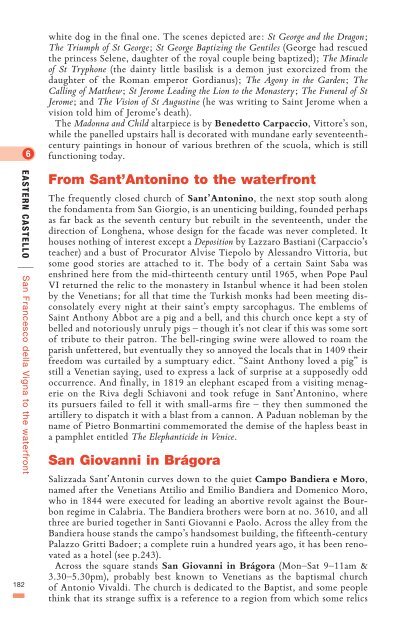You also want an ePaper? Increase the reach of your titles
YUMPU automatically turns print PDFs into web optimized ePapers that Google loves.
white dog in <strong>the</strong> final one. <strong>The</strong> scenes depicted are: St George <strong>and</strong> <strong>the</strong> Dragon;<br />
<strong>The</strong> Triumph of St George; St George Baptizing <strong>the</strong> Gentiles (George had rescued<br />
<strong>the</strong> princess Selene, daughter of <strong>the</strong> royal couple being baptized); <strong>The</strong> Miracle<br />
of St Tryphone (<strong>the</strong> dainty little basilisk is a demon just exorcized from <strong>the</strong><br />
daughter of <strong>the</strong> Roman emperor Gordianus); <strong>The</strong> Agony in <strong>the</strong> Garden; <strong>The</strong><br />
Calling of Mat<strong>the</strong>w; St Jerome Leading <strong>the</strong> Lion <strong>to</strong> <strong>the</strong> Monastery; <strong>The</strong> Funeral of St<br />
Jerome; <strong>and</strong> <strong>The</strong> Vision of St Augustine (he was writing <strong>to</strong> Saint Jerome when a<br />
vision <strong>to</strong>ld him of Jerome’s death).<br />
<strong>The</strong> Madonna <strong>and</strong> Child altarpiece is by Benedet<strong>to</strong> Carpaccio, Vit<strong>to</strong>re’s son,<br />
while <strong>the</strong> panelled upstairs hall is decorated with mundane early seventeenthcentury<br />
paintings in honour of various brethren of <strong>the</strong> scuola, which is still<br />
functioning <strong>to</strong>day.<br />
eastern castello<br />
|<br />
182<br />
San Francesco della Vigna <strong>to</strong> <strong>the</strong> waterfront<br />
From Sant’An<strong>to</strong>nino <strong>to</strong> <strong>the</strong> waterfront<br />
<strong>The</strong> frequently closed church of Sant’An<strong>to</strong>nino, <strong>the</strong> next s<strong>to</strong>p south along<br />
<strong>the</strong> fondamenta from San Giorgio, is an unenticing building, founded perhaps<br />
as far back as <strong>the</strong> seventh century but rebuilt in <strong>the</strong> seventeenth, under <strong>the</strong><br />
direction of Longhena, whose design for <strong>the</strong> facade was never completed. It<br />
houses nothing of interest except a Deposition by Lazzaro Bastiani (Carpaccio’s<br />
teacher) <strong>and</strong> a bust of Procura<strong>to</strong>r Alvise Tiepolo by Aless<strong>and</strong>ro Vit<strong>to</strong>ria, but<br />
some good s<strong>to</strong>ries are attached <strong>to</strong> it. <strong>The</strong> body of a certain Saint Saba was<br />
enshrined here from <strong>the</strong> mid-thirteenth century until 1965, when Pope Paul<br />
VI returned <strong>the</strong> relic <strong>to</strong> <strong>the</strong> monastery in Istanbul whence it had been s<strong>to</strong>len<br />
by <strong>the</strong> Venetians; for all that time <strong>the</strong> Turkish monks had been meeting disconsolately<br />
every night at <strong>the</strong>ir saint’s empty sarcophagus. <strong>The</strong> emblems of<br />
Saint Anthony Abbot are a pig <strong>and</strong> a bell, <strong>and</strong> this church once kept a sty of<br />
belled <strong>and</strong> no<strong>to</strong>riously unruly pigs – though it’s not clear if this was some sort<br />
of tribute <strong>to</strong> <strong>the</strong>ir patron. <strong>The</strong> bell-ringing swine were allowed <strong>to</strong> roam <strong>the</strong><br />
parish unfettered, but eventually <strong>the</strong>y so annoyed <strong>the</strong> locals that in 1409 <strong>the</strong>ir<br />
freedom was curtailed by a sumptuary edict. “Saint Anthony loved a pig” is<br />
still a Venetian saying, used <strong>to</strong> express a lack of surprise at a supposedly odd<br />
occurrence. And finally, in 1819 an elephant escaped from a visiting menagerie<br />
on <strong>the</strong> Riva degli Schiavoni <strong>and</strong> <strong>to</strong>ok refuge in Sant’An<strong>to</strong>nino, where<br />
its pursuers failed <strong>to</strong> fell it with small-arms fire – <strong>the</strong>y <strong>the</strong>n summoned <strong>the</strong><br />
artillery <strong>to</strong> dispatch it with a blast from a cannon. A Paduan nobleman by <strong>the</strong><br />
name of Pietro Bonmartini commemorated <strong>the</strong> demise of <strong>the</strong> hapless beast in<br />
a pamphlet entitled <strong>The</strong> Elephanticide in <strong>Venice</strong>.<br />
San Giovanni in Brágora<br />
Salizzada Sant’An<strong>to</strong>nin curves down <strong>to</strong> <strong>the</strong> quiet Campo B<strong>and</strong>iera e Moro,<br />
named after <strong>the</strong> Venetians Attilio <strong>and</strong> Emilio B<strong>and</strong>iera <strong>and</strong> Domenico Moro,<br />
who in 1844 were executed for leading an abortive revolt against <strong>the</strong> Bourbon<br />
regime in Calabria. <strong>The</strong> B<strong>and</strong>iera bro<strong>the</strong>rs were born at no. 3610, <strong>and</strong> all<br />
three are buried <strong>to</strong>ge<strong>the</strong>r in Santi Giovanni e Paolo. Across <strong>the</strong> alley from <strong>the</strong><br />
B<strong>and</strong>iera house st<strong>and</strong>s <strong>the</strong> campo’s h<strong>and</strong>somest building, <strong>the</strong> fifteenth-century<br />
Palazzo Gritti Badoer; a complete ruin a hundred years ago, it has been renovated<br />
as a hotel (see p.243).<br />
Across <strong>the</strong> square st<strong>and</strong>s San Giovanni in Brágora (Mon–Sat 9–11am &<br />
3.30–5.30pm), probably best known <strong>to</strong> Venetians as <strong>the</strong> baptismal church<br />
of An<strong>to</strong>nio Vivaldi. <strong>The</strong> church is dedicated <strong>to</strong> <strong>the</strong> Baptist, <strong>and</strong> some people<br />
think that its strange suffix is a reference <strong>to</strong> a region from which some relics







